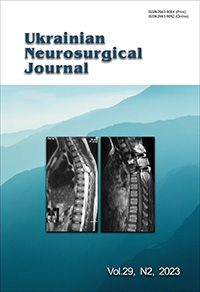Surgical treatment of hemangiopericytoma with intracanal and paravertebral growth. Clinical case
DOI:
https://doi.org/10.25305/unj.276499Keywords:
spinal hemangiopericytoma, spinal tumor removal, surgical treatment of hemangiopericytomaAbstract
Hemangiopericytoma can occur anywhere in the body where capillaries are located. However, most often this tumor is detected in the subcutaneous soft tissues, pelvic ring, lower limbs and retroperitoneal space [2]. Hemangiopericytoma rarely affects the central nervous system. Because of the rarity of the disease, the clinical features, treatment, and outcomes are poorly understood.
Patient M, 64 years old, male, applied to the polyclinic of the State University "Institute of Neurosurgery named after Acad. A.P. Romodanov of the National Academy of Medical Sciences of Ukraine" with complaints of pain in the thoracic spine with radiation to the left subscapular region of the body, numbness and weakness in the lower limbs. After an MRI, a diagnosis of a tumor of Th5-Th6 vertebrae was established. Given the presence of a spinal tumor in the patient with spinal cord compression, a decision was made to perform an operation to remove the tumor as a priority. After surgery, the patient's radicular pain and leg weakness immediately disappeared. CT was performed. The tumor was removed completely.
Hemangiopericytomas are aggressive neoplasms with a high recurrence rate and a tendency to metastasize. The recurrence rate of hemangiopericytoma ranges from 50 to 80%, and metastases - from 14 to 30%, but can be as high as 23-64%, which makes the treatment of this disease very difficult. Surgical intervention and postoperative irradiation in a dose of up to 60 Gy, based on the data of the literature review, significantly improves treatment outcomes and reduces the number of recurrences compared to surgery alone. Surgical resection of the tumor should be total, if possible, in cases when the tumor cannot be removed completely, it should be removed as subtotal as possible.
References
1. Van den Brande R, Cornips EM, Peeters M, Ost P, Billiet C, Van de Kelft E. Epidemiology of spinal metastases, metastatic epidural spinal cord compression and pathologic vertebral compression fractures in patients with solid tumors: A systematic review. J Bone Oncol. 2022 Jul 9;35:100446. [CrossRef] [PubMed] [PubMed Central]
2. World Health Organization. Who Report on Cancer: Setting Priorities, Investing Wesely and Providing Care for All.; 2020.
3. Allemani C, Matsuda T, Di Carlo V, Harewood R, Matz M, Nikšić M, Bonaventure A, Valkov M, Johnson CJ, Estève J, Ogunbiyi OJ, Azevedo E Silva G, Chen WQ, Eser S, Engholm G, Stiller CA, Monnereau A, Woods RR, Visser O, Lim GH, Aitken J, Weir HK, Coleman MP; CONCORD Working Group. Global surveillance of trends in cancer survival 2000-14 (CONCORD-3): analysis of individual records for 37 513 025 patients diagnosed with one of 18 cancers from 322 population-based registries in 71 countries. Lancet. 2018 Mar 17;391(10125):1023-1075. [CrossRef] [PubMed] [PubMed Central]
4. Kypriotakis G., Vidrine D.J., Francis L.E., Rose J.H. The longitudinal relationship between quality of life and survival in advanced stage cancer. Psychooncology. 2016;25(2):225–231. [CrossRef]
5. Ediebah D.E., Coens C., Zikos E., et al. Does change in health-related quality of life score predict survival? Analysis of EORTC 08975 lung cancer trial. Br. J. Cancer. 2014;110(10):2427–2433. [CrossRef]
6. Shrestha A., Martin C., Burton M., Walters S., Collins K., Wyld L. Quality of life versus length of life considerations in cancer patients: A systematic literature review. Psycho-Oncology. 2019;28(7):1367–1380. [CrossRef]
Downloads
Published
How to Cite
Issue
Section
License
Copyright (c) 2023 Ievgenii I. Slynko, Yurii V. Derkach, Arthur I. Ermolev

This work is licensed under a Creative Commons Attribution 4.0 International License.
Ukrainian Neurosurgical Journal abides by the CREATIVE COMMONS copyright rights and permissions for open access journals.
Authors, who are published in this Journal, agree to the following conditions:
1. The authors reserve the right to authorship of the work and pass the first publication right of this work to the Journal under the terms of Creative Commons Attribution License, which allows others to freely distribute the published research with the obligatory reference to the authors of the original work and the first publication of the work in this Journal.
2. The authors have the right to conclude separate supplement agreements that relate to non-exclusive work distribution in the form of which it has been published by the Journal (for example, to upload the work to the online storage of the Journal or publish it as part of a monograph), provided that the reference to the first publication of the work in this Journal is included.









